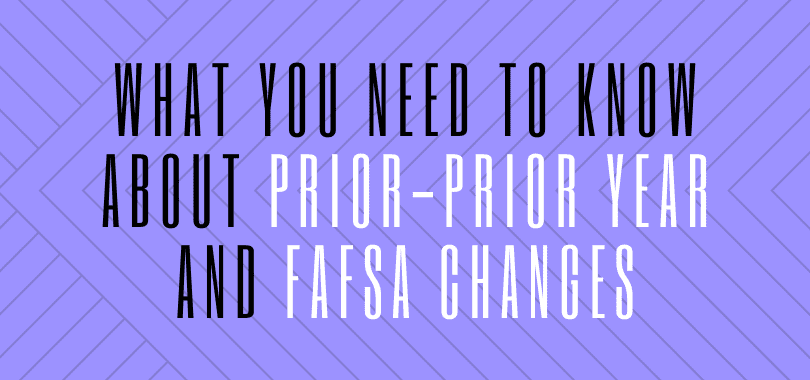Due to the FAFSA Simplification Act passed in 2021, the Free Application for Federal Student Aid (FAFSA) has been undergoing some major changes in the past year. And it’s set to undergo some more for the 2024-2025 award year! This upcoming FAFSA is the biggest overhaul yet of the system, so students and their families need to be aware of the changes.
Read on to discover what major changes the FAFSA form has in store as well as some important dates and information you should note.

When Does the 2024-2025 FAFSA Become Available?
In years past, the FAFSA has always become available on October 1st for the following year. However, with the new FAFSA’s major changes, this release date has been pushed back to December 2023 for the 2024-25 award year.
Although the deadline for this financial award year is June 30th, 2025, it is generally not recommended you wait that long to complete it. Many schools and states have much earlier deadlines for financial aid packages, and the longer you wait, the less likely you are to receive institutional grant aid from colleges.
Most colleges will have FAFSA deadlines in either March or April. With a shorter window to apply this year, students and their families need to be prepared to submit their applications as soon as the new form becomes available online. In fact, the Federal Student Aid Office is encouraging students and parents to do this step now before the new form is available. You can sign up here.
If you have any questions about how your colleges are handling the FAFSA this year, be sure to reach out to their admissions office or financial aid department ahead of time to get the details you need.
Other 2024-2025 FAFSA Updates
In December 2021, Congress passed a package that included emergency pandemic relief as well as policy changes for higher education. A number of changes went into effect on the form that became available in October, but there may be more to come.
Some of these FAFSA Changes include:
- The application has fewer questions (down from 108 to about 36). Questions regarding Selective Service registration, drug-related convictions, and gender have been completely removed. Students and families can also import their tax records.
- The Student Aid Index (SAI) replaces the Expected Family Contribution (EFC). This will help students and their families make better sense of their award letters.
- A new formula for financial aid.
- Pell Grant eligibility information. Additional information will be supplied regarding Pell Grant eligibility ahead of time if students wish to check.
- A new demographic survey. Participation is mandatory, but students can decline the answers.
- The sibling discount is ending. The FAFSA used to account for siblings attending college, which would make it more affordable for families with more than one child to send kids to college.
- FSA ID. Everyone who submits information on the FAFSA, including parents, students, and guardians, must have a FSA ID.
- Consent and approval are needed for federal tax information that is transferred directly from the IRS in order to be eligible for federal financial aid and an SAI.
- Students can now select up to 20 colleges (up from 10) on their online FAFSA form and up to 10 on their FAFSA PDF.
- Click here for a full detailed overview with screenshots.

The New FAFSA Formula
Probably the biggest change that is coming with the new FAFSA is the new formula. For many, this new formula will make it easier than ever to be eligible for federal financial aid programs such as the Pell Grant. The formula removes the number of family members in college, creates different eligibility criteria for Pell Grants, and gives the family more information on their finances and what they will be expected to pay for their student’s education.
With SAI, too, the contribution score can go into the negatives (-1,500) where the EFC could not. This can help distinguish the students with the most need and gives more information to colleges and universities that offer need-based scholarships and grants. There will also be automatic, maximum Pell Grants for families who make less than 175% of the federal poverty level (225% for single parents). With this new calculation, nearly 43% of students who were previously ineligible for a Pell Grant would now be eligible.
These changes are major, and guidance counselors and advisors are undergoing training to better understand the new FAFSA this summer. If you have any questions about how the new form will work and how your SAI will be calculated, reach out to your high school guidance counselor or college financial aid office for more information or assistance.
Ready to File the FAFSA?
There are some significant changes coming to the FAFSA this December, and it’s important to understand how those impact you and your ability to get financial aid. To properly prepare for your application, you should also have a few documents and information on hand, including:
- Your Social Security number or Alien Registration number if you are not a United States citizen
- Yours and/or your parent’s federal income tax returns, W-2s, and other income details
- Records of any untaxed income
- Your FSA ID
- Bank statements
- Records of investments
It’s important to complete your FAFSA to the best of your ability and be truthful – lying on this application or making errors can have serious consequences.
The FAFSA usually has some updates year to year, but the 2024-2025 financial aid award year will definitely see some major changes for applicants. Most of the changes should make the FAFSA easier to complete. But, it will also be a difference maker for students who require financial aid in order to attend college.
If federal financial aid and school financial aid packages are not enough to attend your dream college, scholarships could help you close the gap! Many awards go unclaimed, too, because students don’t know the award exists. To see a list of scholarships you qualify for, start with our Scholarship Search Tool right here.
| Lender | Rates (APR) | Eligibility | |
|---|---|---|---|
 |
5.99%-16.61%* Variable
4.24%-15.61%* Fixed
|
Undergraduate and Graduate
|
VISIT CITIZENS |
 |
5.37% - 15.70% Variable
3.99% - 15.49% Fixed
|
Undergraduate and Graduate
|
VISIT SALLIE MAE |
 |
5.37% - 17.99% Variable
3.79% - 17.99% Fixed
|
Undergraduate and Graduate
|
VISIT CREDIBLE |
 |
5.98% - 13.74% Variable
3.99% - 12.61% Fixed
|
Undergraduate and Graduate
|
VISIT LENDKEY |
 |
5.99% - 15.85% Variable
3.79% - 15.41% Fixed
|
Undergraduate and Graduate
|
VISIT ASCENT |
 |
3.70% - 8.75% Fixed
|
Undergraduate and Graduate
|
VISIT ISL |
 |
5.62% - 16.85% Variable
4.17% - 16.49% Fixed
|
Undergraduate and Graduate
|
VISIT EARNEST |
 |
6.00% - 14.22% Variable
4.50% - 14.22% Fixed
|
Undergraduate and Graduate
|
VISIT ELFI |


